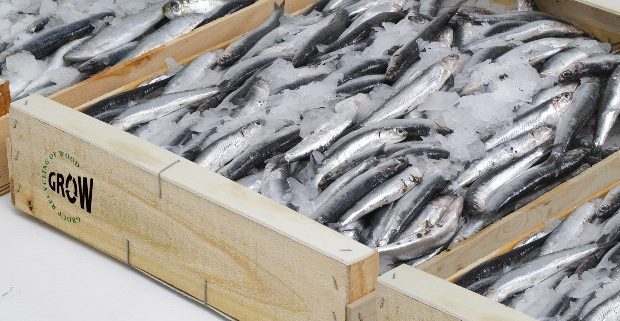Fish, best if stored in wood
The Spanish Federation of Wood Packaging and its components (FEDEMCO) has claimed various administrations of Fisheries and Public Health support for the conservation of fresh fish products in wooden containers, a practice that is increasingly gaining more followers and more recognition in the international arena.
In that sense, countries like Italy or Ireland also defend conformity and hygiene of wooden container for fresh fish, which together with its conservation only with ice, has been traditionally a guarantee of freshness for the consumer, along with commitment to sustainability , origin and less manipulation.
Following the questioning in the last years of its health (even as single-use container), are taking official pronouncements in its favor, both by the absence of public health problems as new scientific evidence. In this line, the Italian employers of wood packaging, Assoimballaggi, has announced the Ministry of Health of Italy a comparative microbiological study of fish containers Autonomous University of Barcelona (UAB). This, widely disseminated within and outside Spain, concludes the suitability of wood in contact with fresh fish.
As a result, the Italian health authority has sent last April a letter to the chain of fish which highlights the following:
“The use of wood is not prohibited in the packaging of fishery products, including packaging aboard the vessels”.
“The containers that are not easy to clean can not be reused, like those that can but are worn out, because are potential vehicles of food contamination”.
“Community legislation establishes general requirements for all materials. The operator and the administration must ensure that the food contact material is not a source of contamination, safely stored and reused if it is easy to clean and disinfect. “
Voices in favor in Spain and Ireland
It is important to remember that other European governments have also taken similar positions. In this sense, Spain, through the Spanish Agency of Consumer Affairs, Food Safety and Nutrition (AECOSAN), as stated in 2008 that the European legal framework fresh fish (R (EC) 853/2004) “does not specifically state permitted materials or prohibited for packaging products, but the general conditions of the containers so that meet its objectives. ”
In Ireland, the Authority Fisheries Protection (SFPA), in a letter to the European Commission in 2010, states that “with its use for years, wood has proven to be an excellent means of storing fish. When used correctly, this type of boxes guarantee a good ratio between fish and ice and allow good drainage of water from melting ice. The SFPA does not consist public health problems caused by the use of single-use containers, whether in Ireland or another member state. ”
Ice management, fundamental to the quality and hygiene fisheries
Similarly, FEDEMCO Administration has claimed that the legal framework is respected in the management of ice in containers. This reference is quite important in the current context of “fresh fish market”. Especially in Spain, where it highlights how the replacement of board wooden containers single use expanded polystyrene cases without drains, or other links in the chain, it is encouraging and tolerating improper use regulated in the aforementioned European legal framework.
A legislation which provides that the packaging, besides being “waterproof”, “should prevent water from melting ice is in contact with the products.” This second requirement, the conservation ice without cooling water, has been reflected in the health rules for the production and marketing of fishery products for more than 30 years ago in Spain according to different formulas above as: the existence of “drains” or the “evacuation of water from melting ice.”
Meanwhile, the wording of the requirements to the characteristics of the packaging material established for 20 years (1984-2004) that “non-returnable containers resist the manipulations during distribution” or “will have the necessary strength to ensure effective protection fishery products”, or that “certain special types of packaging smooth waterproof material, resistant to corrosion and easy to wash and disinfect may be used again after cleaning and disinfection”. Paradoxically since 2004 the European regulation summarizes the above as “water resistant”, opening the interpretation that only synthetic or reusable materials conform per se, regardless of their hygienic conditions, and no statistics official control or scientific evidence to support it.
However, studied the contact of the fish with a natural material like wood in comparison with plastic materials in the aforementioned study by the Faculty of Veterinary Medicine at the UAB, Dr. Rodriguez Jerez concludes that it not only “no unhygienic implications” but “it has antimicrobial properties and is the material that has less contamination after contact with fish.”
Therefore, FEDEMCO is claiming to different administrations fisheries and public health their intervention to ensure consumer compliance with health standards and ensure the industry of wooden packaging equality in the basic conditions of exercise economic activity.
Sector food packaging timber
Spain has a dedicated to the manufacture of wooden packaging food sector, led by FEDEMCO, with more than 100 SMEs and a turnover exceeding 350 million euros, which employs more than 2,500 people.
Its market is mainly in the domestic and foreign packaging and distribution of fresh refrigerated products. Mainly fruits and vegetables, seafood and shellfish, but also other processed foods such as wines, cheeses, meats, sweets, etc. more than 600 million units are manufactured annually, according to various sizes and formats.
This sector is a benchmark for quality worldwide thanks to the Spanish agrifood export strength, and consumed mainly raw materials of domestic origin. It is wood from sustainable plantations of poplar and pine, either in form or processed as sawn board, agroforestry and industrial activities which promote the maintenance and development of rural areas.
Wood is a traditional material accepted by the European Union for food contact. However it fall prejudices or misconceptions about their hygiene lower against the plastic, so it has been the subject of numerous studies that confirm an equal or upper compartment for its natural antimicrobial properties.
Source: FEDEMCO








